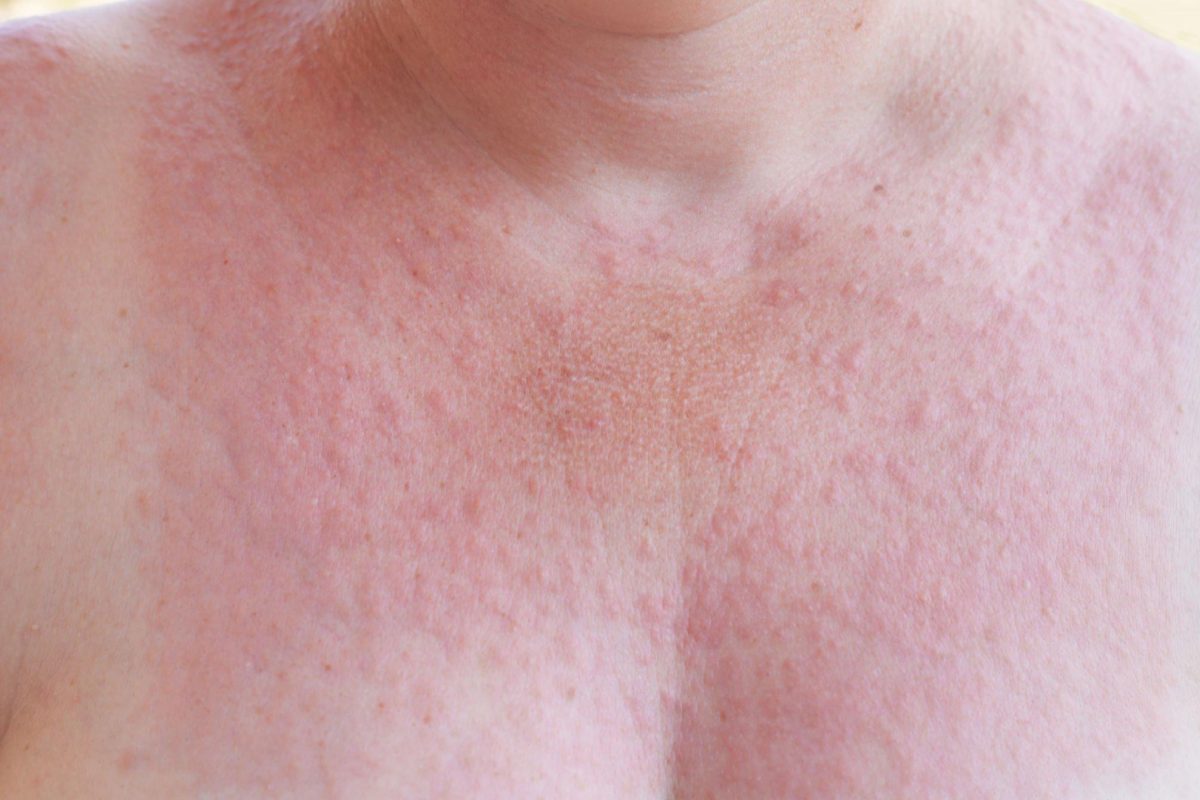Sun allergy is caused by overactive sunlight on the skin. In addition to this sunlight, congenital diseases can provoke it (Gunther’s disease, pellagra), and plants and products become triggers. Symptoms include a rash, itching, pink or brown spots and sometimes a high fever.
Allergy treatment will carry out with special ointments (some of which are hormonal) and tablets.
Table of Contents
Causes Of Sun Allergy On The Skin
The exact reasons for such a body reaction to the sun are still unknown; doctors will incline to believe that the hereditary factor plays a significant role. But several factors provoking this condition, experts have identified accurately:
- autoimmune diseases – for example, systemic lupus erythematosus;
- decorative cosmetics of inadequate quality;
- long-term use of hormonal, antibacterial drugs, non-steroidal anti-inflammatory drugs;
- perfumes, colognes, toilet water;
- household chemicals – for example, the use of antibacterial soap;
- dishes with additives – sweeteners, flavour enhancers.
The paradox is that an allergy to the sun can occur when using a variety of cosmetics. Sunscreens, gels and milk are no exception – if they contain benzophenones or para-aminobenzoic acid, then the risk of photodermatitis symptoms increases by almost 100%
Plants Provocateurs
If furocoumarins, substances contained in the field, forest and meadow herbs, get on the skin, then the appearance of an allergy to the sun is almost inevitable. The most dangerous in this regard are:
- nettle, sedge, clover;
- buckwheat, agrimony, fig tree;
- quinoa, St. John’s wort, angelica.
Foods And Drinks That Promote The Development Of The Reaction
Some foods can also provoke an acute inadequate reaction of the body to the sun’s rays. For example, doctors categorically do not recommend eating the following products before going outside on sunny days:
- parsley and bell pepper;
- figs and celery (greens);
- carrot and citrus juices;
- sorrel, nuts, chocolate;
- alcoholic drinks of any strength.
The above-provoking factors will not consider when diagnosing a rare form of photodermatosis – Gunther’s disease (the second name is porphyria). This disease is incurable and considered hereditary, and patients will force to hide from the sun’s rays all their lives.
Sun Allergy Symptoms On The Skin
Signs of an allergy to the sun include red spots, minor rashes, obsessive itching, and a feeling of skin tightness. Their location does not depend on whether there was direct exposure to sunlight on certain parts of the body or face.
Spots, Rashes
Spots and rashes are the primary symptoms that appear after exposure to the sun, even for a short time. The spots can be brown and red but are always irregular in shape and “free” on the body and face. That is, it is impossible to designate unique places for hyperemic areas; they can appear on the shoulders, hands
Usually, along with spots on the skin, a rash appears – small pimples without internal contents. They can be located in rounded areas or stripes or be “scattered” throughout the body.
Skin Itches (Itching)
Itching is a secondary sign of an allergy to the sun; the skin begins to itch after the person has gone into the shade, entered the room and cooled down. The itching starts as a mild one, especially not bothering. But after a few hours, the skin itches so severely that it is impossible to resist – a person can injure himself and remove the top layer of the epidermis with his nails.
Considering that the skin at this moment will characterize excessive sensitivity, the infection provoked – will aggravate the condition, increase the overall body temperature, and the formation of wounds with purulent contents.
Itching with an allergy to the sun is so severe that even during sleep, a person cannot control himself. Often, scratching on the skin is found in the morning; you can only avoid this with the help of specific medications.
Sun Allergy Treatment On The Skin
The best option in the presence of classic symptoms of sun allergy on the skin is to seek help from a dermatologist because the doctor will be able to identify the actual cause of the inadequate reaction of the body and prescribe a competent, effective treatment in a particular case.
If, for example, rashes, itching and spots appeared after the use of any cosmetics, then they should be excluded from service. Likewise, if the cause of the allergy was taking medications, you need to either cancel them or avoid exposure to sunlight on bare skin, reducing the time spent on the street.
Prevention Of Allergic Reactions To The Sun
- Predicting the body’s reaction to the sun’s rays is tough. People who have been sunbathing for years and have not will burn may one day find themselves with pronounced symptoms of the problem. Therefore, there are no specific recommendations for prevention, only general advice from experts:
- Before going outside, do not use decorative cosmetics and perfumes. But, of course, you should not act so radically.
- Should wear clothing from natural fabrics – cotton and linen. Choosing light suits that cover the skin from the sun as much as possible is advisable. Headwear is a must-have summer wardrobe item.
- Should e use sunscreens with a high SPF at all times? Ensure that the selected cream, milk, and spray protects from all types of sunlight (infrared, ultraviolet, long, short).
- In the evening, the body’s skin should be washed under a warm shower and treated with moisturizing and nourishing creams. It will increase immunity in the dermis at the cellular level, and it can actively resist the sun’s rays.
- You need to adjust your diet. It is worth raising alcoholic beverages, spicy and pickled, salty foods and dishes. You can not allow body dehydration – carrying a bottle of water with you is advisable.

